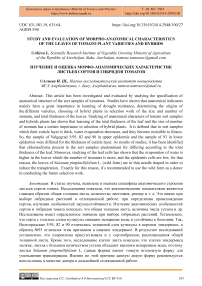Study and evaluation of morpho-anatomical characteristics of the leaves of tomato plant varieties and hybrids
Автор: Alieva I.
Журнал: Бюллетень науки и практики @bulletennauki
Рубрика: Сельскохозяйственные науки
Статья в выпуске: 3 т.10, 2024 года.
Бесплатный доступ
This article has been investigated and evaluated by studying the specification of anatomical structure of the sort samples of tomatoes. Studies have shown that anatomical indicators mainly have a great importance in learning of drought resistance, determining the origins of the different varieties, choosing of hybrid plants in selection work of the size and number of stomata, and total thickness of the leaves. Studying of anatomical characters of tomato sort samples and hybrids plants has shown that learning of the total thickness of the leaf and the size of number of stomata has a certain importance in selection of hybrid plants. It is defined that in sort samples which their cuticle layer is thick, water evaporation decreases, and they become resistible to illness. So, the sample of Volgograd 5/95, 82 and 90 in upper epidermis and the sample of 93 in lower epidermis were differed for the thickness of cuticle layer. As results of studies, it has been identified that chlorenchyma present in the sort samples predominant for differing according to the total thickness of the leaf. Moreover, studying of the leaf cells has shown that the evaporation of water is higher in the leaves which the number of stomatas is more, and the epidermis cells are few, for that reason, the leaves of Solanum pimpinellifolium L. (wild form) are in thin needle shaped in order to reduce the transpiration. Exactly for this reason, it’s recommended to use the wild form as a donor in conducting the future selection work.
Tomatoes, varieties, hybrids, morphology, anatomy
Короткий адрес: https://sciup.org/14129702
IDR: 14129702 | УДК: 631.581.19, | DOI: 10.33619/2414-2948/100/27
Список литературы Study and evaluation of morpho-anatomical characteristics of the leaves of tomato plant varieties and hybrids
- Брежнев Д. Д. Томаты. Л.: Колос, 1964. 320 с.
- Isah A. S., Amans E. B., Odion E. C., Yusuf A. A. Growth rate and yield of two tomato varieties (Lycopersicon esculentum Mill) under green manure and NPK fertilizer rate Samaru Northern Guinea Savanna // International Journal of Agronomy. 2014. V. 2014. DOI: 10.1155/2014/932759
- Figàs M. R., Prohens J., Raigón M. D., Fernández-de-Córdova P., Fita, A., Soler S. Characterization of a collection of local varieties of tomato (Solanum lycopersicum L.) using conventional descriptors and the high-throughput phenomics tool Tomato Analyzer // Genetic Resources and Crop Evolution. 2015. V. 62. №2. P. 189-204. EDN: DBFWBV
- Sardaro M. L. S., Marmiroli M., Maestri E., Marmiroli N. Genetic characterization of Italian tomato varieties and their traceability in tomato food products // Food Science & Nutrition. 2013. V. 1. №1. P. 54-62. DOI: 10.1002/fsn3.8
- Terzopoulos P. J., Bebeli P. J. DNA and morphological diversity of selected Greek tomato (Solanum lycopersicum L.) landraces // Scientia horticulturae. 2008. V. 116. №4. P. 354-361. DOI: 10.1016/j.scienta.2008.02.010 EDN: MFFPKH
- Власов А. С., Власова Т. Г. Селекция беспасынковых томатов // Новые и нетрадиционные растения и перспективы их практического использования: Сборник научных статей. 1998. С. 119-120. EDN: UZSDFD


